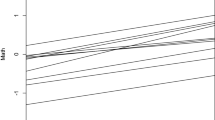Abstract
While effect size estimates, post hoc power estimates, and a priori sample size determination are becoming a routine part of univariate analyses involving measured variables (e.g., ANOVA), such measures and methods have not been articulated for analyses involving latent means. The current article presents standardized effect size measures for latent mean differences inferred from both structured means modeling and MIMIC approaches to hypothesis testing about differences among means on a single latent construct. These measures are then related to post hoc power analysis, a priori sample size determination, and a relevant measure of construct reliability.
Similar content being viewed by others
References
Aiken, L.S., Stein, J.A., & Bentler, P.M. (1994). Structural equation analyses of clinical subpopulation differences and comparative treatment outcomes: Characterizing the daily lives of drug addicts.Journal of Consulting and Clinical Psychology, 62, 488–499.
Aptech Systems. (1996).GAUSS system and graphics manual. Maple Valley, WA: Author.
Bentler, P.M. (1968). Alpha-maximized factor analysis (alphamax): Its relation to alpha and canonical factor analysis.Psychometrika, 33, 335–345.
Bentler, P.M. (1997).EQS structural equations program. Encino, CA: Multivariate Software.
Bentler, P.M., & Chou, C. (1987). Practical issues in structural modeling.Sociological Methods & Research, 16(1), 78–117.
Browne, M.W. (1984). Asymptotically distribution-free methods for the analysis of covariance structures.British Journal of Mathematical and Statistical Psychology, 37, 62–83.
Byrne, B.M., Shavelson, R.J., & Muthén, B. (1989). Testing for the equivalence of factor covariance and mean structures: The issue of partial measurement invariance.Psychological Bulletin, 105, 456–466.
Cleary, T.A., & Linn, R.L. (1969). Error of measurement and the power of a statistical test.British Journal of Mathematical and Statistical Psychology, 22, 49–55.
Cohen, J. (1988).Statistical power analysis for the behavioral sciences (2nd ed.). Hillsdale, NJ: Lawrence Erlbaum Associates.
Crocker, L.M., & Algina, J. (1986).Introduction to classical and modern test theory. New York, NY: Holt, Rinehart and Winston.
Drewes, D.W. (2000). Beyond the Spearman-Brown: A structural approach to maximal reliability.Psychological Methods, 5, 214–227.
Dukes, R.L., Ullman, J.B., & Stein, J.A. (1995). An evaluation of D.A.R.E. (Drug Abuse Resistance Education), using a Solomon four-group design with latent variables.Evaluation Review, 19, 409–435.
Fornell, C., & Larcker, D.F. (1981). Evaluating structural equation models with unobservable variables and measurement error.Journal of Marketing Research, 18, 39–50.
Gallo, J.J., Anthony, J.C., & Muthén, B.O. (1994). Age differences in the symptoms of depression: A latent trait analysis.Journal of Gerontology: Psychological Sciences, 49, 251–264.
Hancock, G.R. (1997). Structural equation modeling methods of hypothesis testing of latent variable means.Measurement and Evaluation in Counseling and Development, 30, 91–105.
Haynam, G.E., Govindarajulu, Z., & Leone, F.C. (1973). Tables of the cumulative non-central chi-square distribution. In H.L. Harter & D.B. Owen (Eds.),Selected tables in mathematical statistics (Vol. 1, pp. 1–78). Chicago: Markham Publishing.
Hedges, L.V., & Olkin, I. (1985).Statistical methods for meta-analysis. New York, NY: Academic Press.
Jöreskog, K.G., & Goldberger, A.S. (1975). Estimation of a model with multiple indicators and multiple causes of a single latent variable.Journal of the American Statistical Association, 70, 631–639.
Kaplan, D., & George, R. (1995). A study of the power associated with testing factor mean differences under violations of factorial invariance.Structural Equation Modeling: A Multidisciplinary Journal, 2, 101–118.
Kinnunen, U., & Leskinen, E. (1989). Teacher stress during the school year: Covariance and mean structure analyses.Journal of Occupational Psychology, 62, 111–122.
Li, H., Rosenthal, R., & Rubin, D.B. (1996). Reliability of measurement in psychology: From Spearman-Brown to maximal reliability.Psychological Methods, 1, 98–107.
MacCallum, R.C., Browne, M.W., & Sugawara, H.M. (1996). Power analysis and determination of sample size for covariance structure modeling.Psychological Methods, 1, 130–149.
Maxwell, S.E. (1980). Dependent variable reliability and determination of sample size.Applied Psychological Measurement, 4, 253–260.
Muthén, B.O. (1989). Latent variable modeling in heterogeneous populations.Psychometrika, 54, 557–585.
Nunnally, J.C., & Bernstein, I.H. (1994).Psychometric theory (3rd ed.). New York, NY: McGraw-Hill.
SAS Institute. (1996).SAS statistical software. Cary, NC: Author.
Satorra, A., & Bentler, P.M. (1994). Corrections to test statistics and standard errors in covariance structure analysis. In A. von Eye & C.C. Clogg (Eds.),Latent variables analysis: Applications for developmental research (pp. 399–419). Thousand Oaks, CA: SAGE Publications.
Satorra, A., & Saris, W.E. (1985). Power of the likelihood ratio test in covariance structure analysis.Psychometrika, 50, 83–90.
Sörbom, D. (1974). A general method for studying differences in factor means and factor structure between groups.British Journal of Mathematical and Statistical Psychology, 27, 229–239.
Author information
Authors and Affiliations
Corresponding author
Additional information
I wish to convey my appreciation to the reviewers and Associate Editor, whose suggestions extended and strengthened the article's content immensely, and to Ralph Mueller of The George Washington University for enhancing the clarity of its presentation.
Rights and permissions
About this article
Cite this article
Hancock, G.R. Effect size, power, and sample size determination for structured means modeling and mimic approaches to between-groups hypothesis testing of means on a single latent construct. Psychometrika 66, 373–388 (2001). https://doi.org/10.1007/BF02294440
Received:
Revised:
Issue Date:
DOI: https://doi.org/10.1007/BF02294440




